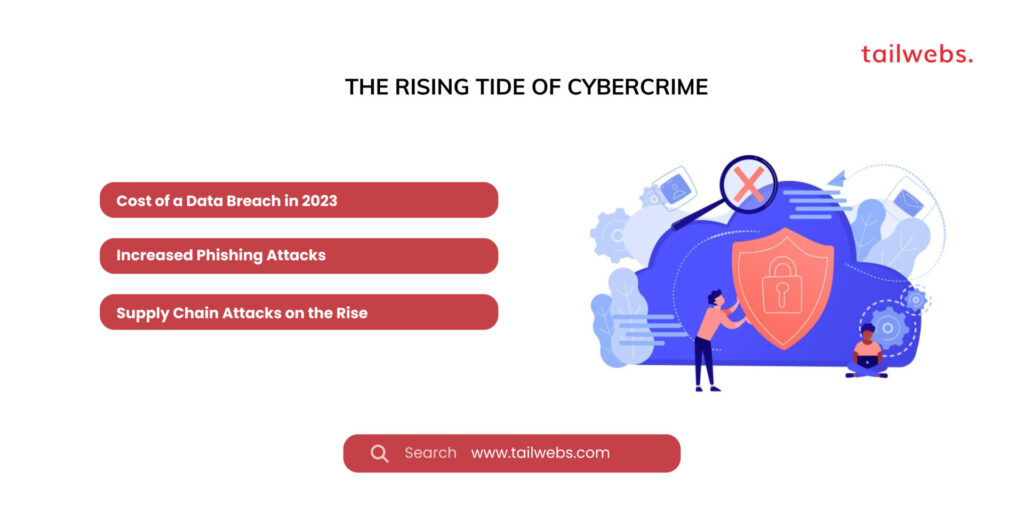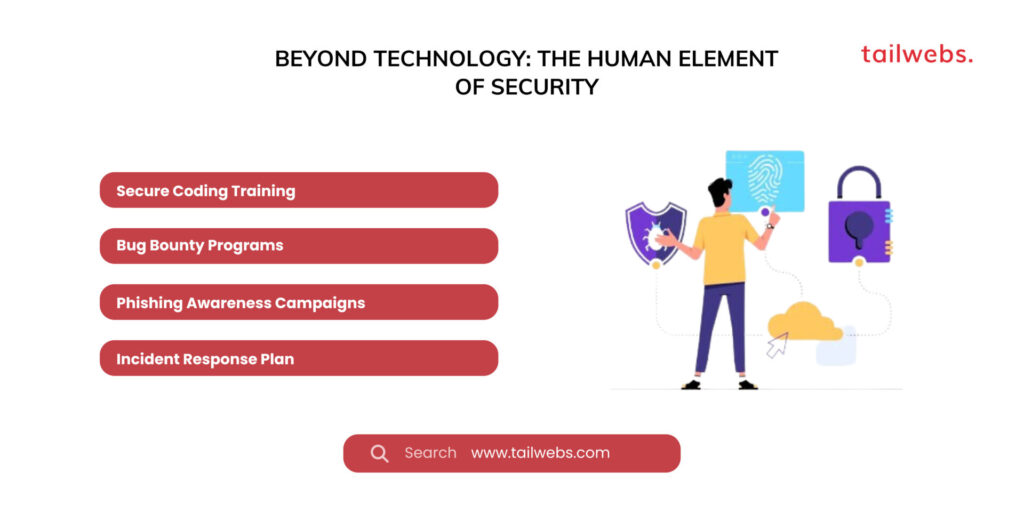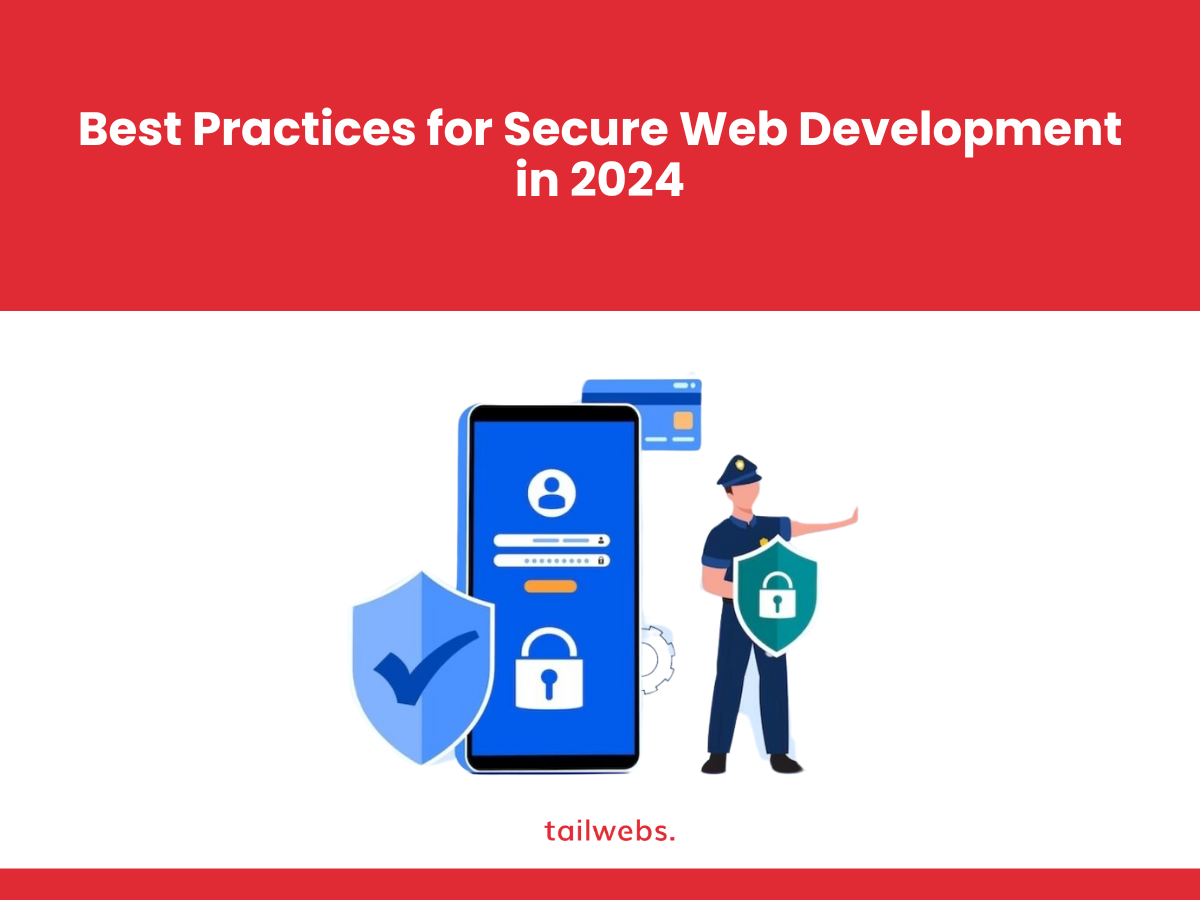In today’s digital age, web security is no longer an afterthought – it’s a fundamental necessity. As cyber threats evolve at an alarming rate, so too must the practices employed by web developers to safeguard websites and user data. This comprehensive guide delves into the best practices for secure web development in 2024, empowering you to build robust and resilient web applications that can withstand sophisticated attacks.
The Rising Tide of Cybercrime
The cybercrime landscape is constantly shifting, with attackers devising ever-more intricate methods to exploit vulnerabilities in web applications. Here’s a glimpse into the concerning reality:
Cost of a Data Breach in 2023:
The average cost of a data breach reached a staggering $4.35 million globally in 2023, according to the IBM Cost of a Data Breach Report 2023.
Increased Phishing Attacks:
Phishing attempts continue to rise, with a reported 32% of businesses experiencing phishing attacks in 2023 alone (Verizon 2023 DBIR).
Supply Chain Attacks on the Rise:
Supply chain attacks, which target third-party vendors to gain access to a wider network, are becoming a growing concern.
These statistics highlight the critical need for robust web security practices. By implementing the best practices outlined below, you can significantly reduce the risk of cyberattacks and protect your users’ valuable data.

Building a Secure Web Development Foundation
Here are the cornerstones of secure web development in 2024:
Secure Coding Practices:
Input Validation and Sanitization:
Always validate and sanitize user input to prevent malicious code injection attacks like SQL injection and Cross-Site Scripting (XSS).
Output Encoding:
Encode all data displayed on the web page to prevent attackers from injecting malicious scripts.
Secure Use of APIs:
Ensure proper authentication and authorization mechanisms are in place when interacting with APIs to prevent unauthorized access to sensitive data.
Use of Secure Coding Standards:
Adhere to established secure coding standards like OWASP Top 10 to identify and mitigate common web application vulnerabilities.
HTTPS Everywhere:
Enforce HTTPS (Hypertext Transfer Protocol Secure) for all website communication. HTTPS encrypts data transmission between the user’s browser and the web server, safeguarding sensitive information like login credentials and credit card details.
Regular Security Audits and Penetration Testing:
Conduct regular security audits and penetration testing to identify and address potential vulnerabilities in your web application before attackers exploit them.
Least Privilege Principle:
Implement the principle of least privilege, granting users only the minimum level of access required to perform their tasks. This minimizes the potential damage if an attacker gains unauthorized access.
Secure Password Management:
Enforce strong password policies, encourage users to enable multi-factor authentication, and implement secure password hashing techniques to protect user credentials.
By adhering to these fundamental practices, you lay a solid foundation for a secure web development environment.
Staying Ahead of the Curve: Advanced Security Measures
As web development practices evolve, so too do the security measures required to stay ahead of cybercriminals. Here are some advanced security considerations for 2024:
API Security:
With the increasing popularity of APIs, it’s crucial to implement robust API security measures such as API key authentication, rate limiting, and comprehensive authorization controls.
Content Security Policy (CSP):
Implement a Content Security Policy (CSP) to restrict the sources from which web pages can load scripts, stylesheets, and other resources. This mitigates the risk of XSS attacks.
Secure Server Configuration:
Maintain secure server configurations by keeping software up to date, patching vulnerabilities promptly, and disabling unnecessary services.
Data Encryption at Rest and in Transit:
Encrypt sensitive data at rest (stored on servers) and in transit (being transmitted) to minimize the risk of data breaches even if attackers gain access to your system.
Regular Security Awareness Training:
Educate your development team on the latest cyber threats and best practices for secure coding. Foster a security-conscious culture within your organization.
The strategic use of high-standard VPNs further enhances the security of data in transit, providing an essential tool in the battle against cybercrime.
By incorporating these advanced measures into your web development process, you significantly enhance the overall security posture of your web applications.
Beyond Technology: The Human Element of Security
While technology plays a critical role in securing web applications, the human element remains a vital consideration. Here’s how to address the human aspect of security:
Secure Coding Training:
Invest in security awareness training for your development team to equip them with the knowledge and skills to write secure code.
Bug Bounty Programs:
Consider implementing a bug bounty program to incentivize white hat hackers to identify and report vulnerabilities in your web application. This proactive approach can help you discover and address security issues before they are exploited by malicious actors.
Phishing Awareness Campaigns:
Educate your employees about phishing scams and how to identify suspicious emails and attachments. Regular phishing simulations can help test employee awareness and preparedness.
Incident Response Plan:
Develop a comprehensive incident response plan that outlines the steps to take in case of a security breach. This plan should include procedures for identifying, containing, and remediating the breach, as well as notifying affected users and authorities.
By addressing the human element of security, you empower your team to become active participants in safeguarding your web applications.

Essential Tools and Resources for Secure Web Development
Here are some valuable tools and resources to elevate your secure web development practices:
Static Application Security Testing (SAST) Tools:
SAST tools analyze your source code to identify potential security vulnerabilities. Popular options include Snyk, Veracode, and Fortify.
Dynamic Application Security Testing (DAST) Tools:
DAST tools simulate real-world attacks to identify vulnerabilities in your web application. Popular options include Acunetix, Netsparker, and Burp Suite.
Web Application Firewalls (WAFs):
WAFs act as a security barrier between your web application and the internet, filtering out malicious traffic. Popular options include Cloudflare WAF, Imperva WAF, and Sucuri WAF.
Secure Coding Guidelines:
Utilize established secure coding guidelines such as OWASP Top 10 and CWE Top 25 to identify and mitigate common web application vulnerabilities.
Security Training Resources:
Several online platforms offer security training resources and certifications for developers. Consider platforms like SANS Institute, Pentester Academy, and Offensive Security.
By leveraging these tools and resources, you can streamline your secure development process, identify and address vulnerabilities early in the development lifecycle, and build more robust web applications.
Taking Action: Fortifying Your Digital Fortress
Here are concrete steps you can take to implement these best practices and fortify your digital fortress:
Conduct a Security Assessment:
Start by conducting a comprehensive security assessment of your web application to identify any existing vulnerabilities.
Prioritize Security Throughout the Development Lifecycle:
Integrate security practices into every stage of your development process, from initial design to deployment and ongoing maintenance.
Stay Updated on Security Threats:
Continuously monitor the latest cyber threats and update your security measures accordingly.
Promote a Security-Conscious Culture:
Foster a culture of security awareness within your organization by educating employees and developers on best practices.
Regular Penetration Testing:
Schedule regular penetration testing to proactively identify and address vulnerabilities before attackers exploit them.
By following these actionable steps and continuously refining your approach, you can significantly enhance the security posture of your web applications and build trust with your users by demonstrating your commitment to protecting their data.
Conclusion: Building Secure Web Applications for a Safer Digital Future
In conclusion, secure web development is not a one-time endeavor; it’s an ongoing process that requires continuous vigilance and adaptation. By adhering to the best practices outlined in this guide, leveraging valuable tools and resources, and fostering a security-conscious culture within your organization, you can build robust web applications that are resilient against ever-evolving cyber threats. Remember, a secure digital environment is not just about protecting data – it’s about building trust, ensuring business continuity, and safeguarding your reputation in the online world.
Embrace the principles of secure web development, fortify your digital fortress, and empower your web applications to thrive in the ever-evolving digital landscape.





